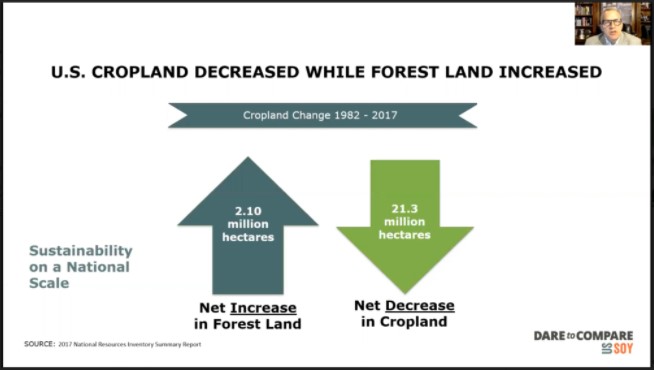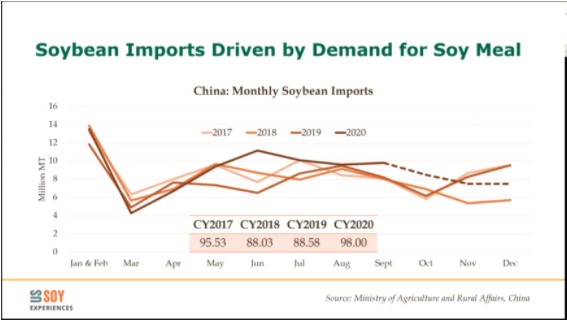Global Grain Geneva 2020 took place on a virtual platform from November 17 to 19. USSEC served as a gold sponsor for this annual conference with USSEC leadership, including CEO Jim Sutter, Regional Director – Greater China Xiaoping Zhang, and Regional Director – Europe / Middle East-North Africa Brent Babb, assuming high-profile speaking roles.
Sutter’s presentation highlighted the 2020 soybean harvest, current stocks, and trade prospects for 2021; utilizing soybean meal mix to maximize livestock production; and growing opportunities for the plant-based protein sector. Zhang spoke about the Chinese response to ASF and its impact on soy consumption. Zhang provided an overview of Chinese pork production; the long-term impact of ASF and structural changes in China’s meat consumption; immediate measures to fight ASF spread; and drivers for soy demand in the Chinese domestic market. Babb served on a panel discussion focusing on challenges and opportunities in the animal feed market, where he discussed sustainability, growth in the MENA region and Europe, the U.S. Soy Sustainability Assurance Protocol (SSAP), and the impact of COVID-19 on feed production and animal protein consumption.
“It’s really important for USSEC to take a leading role in events like Global Grain Geneva,” says Sutter. “We want to be sure that we are connecting with our customers around the world and providing them with the most relevant information about the U.S. Soy Advantage to help them to make good buying decisions for their businesses.”
U.S. SOY: INNOVATION AND ADAPTABILITY
Soy is a growth industry that has seen a 250% increase from 1990 to today, Sutter said during his presentation.As the world continues to develop, Sutter explained, many people are in a position to improve their diets and standard of living. When it comes to demand for protein and cooking oil is rising, soy delivers.
Global consumers’ concerns are also changing, as shown by shifts in purchasing patterns. Consumers are moving away from traditional wet markets to supermarkets and packaged goods, others are moving to ecommerce, and there is a global shift to food preparation at home versus restaurant dining.
Soybean suppliers need to earn trust, said Sutter, and should talk about sustainable practices and multi-generation family farms. Additionally, the supply chain must work together to ensure reliable supply from field to table.
“I believe the pandemic is also driving people to think more about innovation and think more about how they can adapt and how can they become more efficient,” Sutter stated, as he explained how the U.S. soy industry is doing this.
Understanding the details and the data of what is being purchased is important and USSEC’s Dare to Compare campaign highlights the benefits of U.S. Soy to buyers and importers in three different areas: nutrition, sustainability, and oil.
- The Nutrition Value Calculator (NVC) is a decision-making tool that compares the value of different soybean meals.
- The U.S. Soy Sustainability Assurance Protocol (SSAP) verifies that U.S. Soy is sustainable.
- U.S. soy oil’s purity and ease of refining makes it a greater value.
Sutter also pointed out further advantages of U.S. Soy, including technology that drives innovations such as high oleic soybeans; ensuring market access; and providing education to customers. Environmentally, U.S. Soy continues to strive to produce more with less, focusing on both land use and carbon footprint.

“We need to be producing food to feed the world’s people, but we also need to be doing it in a sustainable way,” Sutter summarized.
U.S. SOY: SUSTAINABLE FOOD SECURITY AND FOOD SAFETY IN CHINA
According to Zhang, China is leading the world in producing animal feed with an annual production of around 230 million metric tons (MMT) in 2018/19. This industry has grown from zero to its current size in just under 40 years.
Over the past couple of years, China worked to contain an outbreak of ASF. The virus decimated by the country’s swine herd, but the pork industry is recovering. Additionally, ASF has driven the diversification of meat production and consumption to lessen its reliance on pork. This market is showing strong demand from the recovering hog industry and the growing poultry industry, Zhang said.
China’s crushing industry is the largest in the world and whole soybean imports are driven by demand for soybean meal for this huge feed and animal industry. Crushers also produce soybean oil for cooking.

Click here to see more...